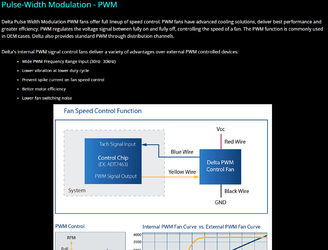- Joined
- Oct 18, 2005
- Location
- Chicago Burbs
For ages I've been used to controlling these 12-20watt mid 100's max CFM Delta fans the usual way, through voltage adjustment devices, so I can run these powerful 120x38mm fans at low voltage, enjoying both superior turbulence against fins and the moderate noise levels (some might call very high) I demand, compared to the quiet 25mm fans everyone uses.
Well, it seems PWM is the thing now, and for good reason. It would appear it is both more power efficient for any given level of fan performance... AND generates less heat in and of itself compared to the under-volting method. I see also that there are many PWM Delta fans on the market now. The only problem, of course, is that the fans I prefer running at partial speed draw enough power that I wouldn't want to attach them to the motherboard headers. I've found a bunch of PWM fan hubs that use SATA/molex power from the PSU, and are controlled entirely by one input from the motherboard. This is good enough for me, however, they do not really specify what their max power per channel or total is. I'm not sure these things could handle, say, 5 of these fans.
Some questions:
1. Just how superior is PWM in terms of power efficiency compared to the usual undervoltage method?
2. Is it true that the undervoltage method really does put out a bunch of extra heat compared to PWM?
3. Are there any PWM fan controller products out there with actual physical control knobs for each individual fan, like the oldschool 3.5/5.25 bay voltage controllers? I can't seem to find any.
Well, it seems PWM is the thing now, and for good reason. It would appear it is both more power efficient for any given level of fan performance... AND generates less heat in and of itself compared to the under-volting method. I see also that there are many PWM Delta fans on the market now. The only problem, of course, is that the fans I prefer running at partial speed draw enough power that I wouldn't want to attach them to the motherboard headers. I've found a bunch of PWM fan hubs that use SATA/molex power from the PSU, and are controlled entirely by one input from the motherboard. This is good enough for me, however, they do not really specify what their max power per channel or total is. I'm not sure these things could handle, say, 5 of these fans.
Some questions:
1. Just how superior is PWM in terms of power efficiency compared to the usual undervoltage method?
2. Is it true that the undervoltage method really does put out a bunch of extra heat compared to PWM?
3. Are there any PWM fan controller products out there with actual physical control knobs for each individual fan, like the oldschool 3.5/5.25 bay voltage controllers? I can't seem to find any.






 After regaining my wits, I found that at maximum, it's only pulling around 9.5 watts out of the wall, but it is much louder than the HHE 0.6a fans at maximum, and pushes a lot more air. I tend to wonder if it would pull more out of the wall if it wasn't behind a fan controller. Doesn't matter to me anyway, because I doubt I'll ever be running it at maximum. That being said, the way it sounds is quite interesting. It has a similar motor buzz to the HHE. At low speeds, it doesn't sound as good as the HHE. However, at higher speeds, the SHE begins to sound better. At comparable RPM, as the HHE starts pushing, say for example, 2100 RPM, the SHE at this RPM actually sounds a bit softer and has a more pleasant note to it. As the RPMs increase, the lower power HHE has a much harder and higher pitch edge to the sound, while the SHE sounds more chill. It's like the SHE is just not working as hard to produce the same RPMs, giving it a more soothing sound. However, once you push the voltage high enough on the SHE, it does eventually get quite a bit louder and more high pitched, but what else would you expect when pushing it at or near its maximum? However, at very low speeds, the HHE sounds better.
After regaining my wits, I found that at maximum, it's only pulling around 9.5 watts out of the wall, but it is much louder than the HHE 0.6a fans at maximum, and pushes a lot more air. I tend to wonder if it would pull more out of the wall if it wasn't behind a fan controller. Doesn't matter to me anyway, because I doubt I'll ever be running it at maximum. That being said, the way it sounds is quite interesting. It has a similar motor buzz to the HHE. At low speeds, it doesn't sound as good as the HHE. However, at higher speeds, the SHE begins to sound better. At comparable RPM, as the HHE starts pushing, say for example, 2100 RPM, the SHE at this RPM actually sounds a bit softer and has a more pleasant note to it. As the RPMs increase, the lower power HHE has a much harder and higher pitch edge to the sound, while the SHE sounds more chill. It's like the SHE is just not working as hard to produce the same RPMs, giving it a more soothing sound. However, once you push the voltage high enough on the SHE, it does eventually get quite a bit louder and more high pitched, but what else would you expect when pushing it at or near its maximum? However, at very low speeds, the HHE sounds better.